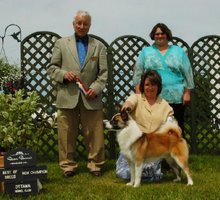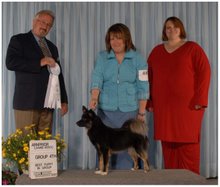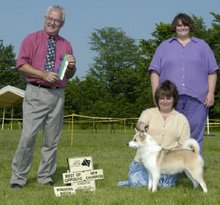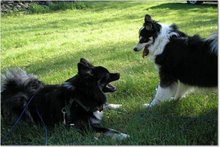This post was on one of the ISD Yahoo Groups, but as always Monika was so very helpful and it is worth having this posted on the website for more folks to read.
"I wrote an article about the breed and wrote a little bit about the “families” and my own personal opinions about the breed. I didn’t write specifically how the families were calculated but I did put a link to Pieter Oliehoek’s study in my article. Here is Pieter’s study: http://www.geneticdiversity.net/dog.html . I’m no expert on the subject but I did speak alot with Pieter at the time and have done alot of personal study of the population through the years with knowledge of the dogs used many years ago as well as dogs exported to other countries. I believed the breed’s longterm future was at stake and have personally used my dogs as “gineau pigs” to bring in new blood especially around the time of the study which has in turn kept my dogs pretty much out of the show ring since. It seems that breeding bloodlines and breeding show dogs don’t always go hand in hand! Then I found that my dogs were losing some of the traits I tried so hard to preserve so my goal has been to keep both in tact, the bloodlines as well as the breed traits. To me both are important. The question is will my dogs benefit the future of the breed by how I decide to breed them or am I just thinking about my own lifetime and how the breed can benefit me! Just a personal thought and the first answer is what has kept me breeding through good and bad.
Very quickly I think I can explain a little bit about the family groups. The pedigree info about the whole population worldwide up to 1997 was put into a special program that calculated how related they are to each other and as a whole and divides them up in families based on specific bloodlines and how widespread they are. If a “new” dog appeared (family info not available OR unknown) for example then that would constitute a new “family” (genetic variation that was “new” to the population). All the dogs that the population was originally built on were founders. On the other hand there were also dogs that were just used so seldom that their blood had become extremely rare in the population as to make them important to breed from just to keep the family bloodline alive. In Iceland there are quite a few families that are rare because we have alot of dogs that are not used often enough either because they were not shown, lived in isolated areas or because people did not think they were nice enough looking. Years ago many dogs were rarer because their progeny was never exported and some dogs who were never used and their family line has been lost. For example one dog named Garpur was his own “family” and he died without ever having progeny, he was an extremely nice dog with a wonderful temperament (hardly seen anymore), not barky or nervous and he had a nice colouring as well. Since I wrote my article I can say that I find that fewer and fewer dogs are being used and more and more people are focussing on dog shows and health tests rather than concentrating on adding genetic variation first and then perfecting the dogs and tweeking. So many people use the same studs over and over and over again on different females or related males on the same females, which is just causing the exact thing that the study was trying to prevent. The same genes are getting spread through the whole population and can’t be avoided in future breedings. As long as we have lots of different families to tap back to then we have posibilities to fix things gone wrong, but if everyone is breeding the same families and bloodlines then there is no genetic variation. The rarer families need to be used alot more, their genepool widened and isolated as well because if they are used too much within the larger family groups then their blood gets lost anyway. If you use a rarer bloodline with the same family lines that are already governing the population then you lose the rare blood very quickly as soon as those individuals are used again with the main population.
What does the M1 gene do? Inquiring minds want to know!!
So the M1 is not a gene per se, it is a group of dogs within a family bloodline that is called M1 in the study. It means that the bloodline was not very popular (could be because of not being show quality, possibly because of isolation or dogs not being used enough from this line) at the time of the study. Today that line has been used alot more and unfortunately we have no new calculation to tell us where the population is at the moment or where it is headed in general. There are still a few lines that are very rare and I´m pretty sure the rarest is still the 0 family line (which you do have individuals from in North America), these dogs are still very few and far between because the “family” started out as 6 individuals and only a few have been used but only for one or two litters each. I am breeding to that line myself and trying to keep it a bit seperate from the larger family lines. The individuals in the original 0 family were not show dogs although they were quite typical including one alspori and one with double dewclaws on three legs. The question is how important is the rare blood? Do we want to preserve it at all costs? I say yes, since once it’s gone it’s lost forever and then no tweeking can bring it back.
The show dogs in Iceland are usually all from the same few families and those are the ones that keep getting used over and over again and are being exported again for their looks. I am a little embarassed to say that most of the best dogs are actually grandpuppies or linebred to a female from my very first litter and I feel that the line is getting much too widespread. It really isn’t fair to the breed when the popular dogs are the only ones bred, alot has to do with finances of owners (how much they can spend on dog shows, tests and “advertisement”), isolation (where the dogs live in relationship to the main breeding kennels) and the general interest of the owners in the world of breeding and showing. Many very good dogs are on working farms and never come out to shows this means that by default their genes are less widespread or they are never used. We can definitely lose good genes that way. I have during the years travelled many miles to mate my females sometimes in horrible weather, at times my travels were in vain but other times I was lucky and got puppies. Then a funny thing happened the other day, I found a wonderful dog who is already 10 years old and has been pretty much “hidden” because he is just a wonderful family member who works with horses and he lives just down the road from me. Oddly enough I found it quite strange to have a usable stud so close to me. J This is extremely sad and unbelievable that even after the study people seem to be less aware of dogs that are very important, few think of what and how they are breeding in regards to genetic variation.
Some are trying to breed to a low inbreeding coefficient which is a good thing for genetic variation for each particular litter (at the same time it gives us less consistency and means that each puppy is equally important in breeding since they are so very different genetically) BUT if the dogs are both in large family groups how low is the coefficient to the rest of the population and how will it be breedable in the future? It all matters, not just numbers on a pedigree. We need variation...many different unrelated males and many different unrelated females used equally in the population. If we have litters with low inbreeding coefficients then those puppies need to all be viewed as totally different individuals. If we have litters with higher coefficients then we can pick the better of the puppies for breeding because the littermates will have alot of the same genes. This is something that most do not realize and they spay or neuter good dogs from a low inbred litter, ending up having to use a genetically less good individual because it has a totally different genetic makeup than his neutered sibling so they cannot and will not give similar puppies.
I think it is wonderful that some of you are actually asking about this study and wanting to learn more. The only thing I would say is make sure you are bringing in the right family lines to do some good in your own population and the population worldwide.
The families were named with letters, the biggest most widespread was A and in the A there were also smaller families A1, A2 etc. Then came B and so on. In the study the families were listed and the countries they were in, some countries only had the A family and didn’t know it, they just kept importing dogs that they liked the look of and didn’t know how related they actually were because they were only looking at 3 gen pedigrees. They considered all these new dogs as “new blood” but in actual fact they were breeding the same genes back into the population that they already had. Then they of course used linebreeding and such to make a specific type. Iceland had as would be expected the most families and most of the rarer lines thus giving us the most different “looks” and the genetic variation was “obvious” in the dogs. Giving the impression to some that our dogs were “inferior” but in actual fact it meant that our population was a genetically healthy one (by means of variation and posibilities for new combinations). That does seem to be changing today, we have a more UNIFORM breed in Iceland at least within the lines that are being used the most because people are breeding what they think will win at shows which means breeding the most popular dogs who are all related. Mind you some of those dogs are now from the families that used to be rarer like the M family but usually mixed with the larger families. I think that I personally like to see variation in type as well as colours because it means that when the newest fashion has gone to extremes then we can go back and fix what needs fixing. I think that any country where the dogs are too similar are probably in danger of being in a genetic crisis in 50 years or probably less! That of course is my opinion and my own thoughts on the breed, I’m sure there are many who like all their dogs to be carbon copies of each other.
I believe that USA is mostly made up of B, H and M families which of course gives you a different population and in turn a different “look” than in other countries but as with all other countries you need new blood that is not the same as you already have if you want to keep the variation in the population and at the same time keep the breed within the current standard (which is always something we have to do as well). Unfortunately my computer is down so I can’t check my database to make sure which families you have but I do know that these three are prominant.
I guess I will let that be my two cents on the subject. Just wanted to chime in and say I am glad to hear that there are people that are curious. J Like I say my computer is down so I have been having trouble with emails and haven’t been keeping a very close eye on lists. But I hope this helps explain a little bit for those interested.
Greetings from Iceland that has SNOW for a change!!!!
Monika
http://www.tofradogs.com/
Subscribe to:
Post Comments (Atom)







No comments:
Post a Comment